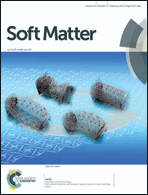Auxetic materials with negative Poisson's ratios have important applications across a broad range of engineering areas, such as biomedical devices, aerospace engineering and automotive engineering. A variety of design strategies have been developed to achieve artificial auxetic materials with controllable responses in the Poisson's ratio. The development of designs that can offer isotropic negative Poisson's ratios over large strains can open up new opportunities in emerging biomedical applications, which, however, remains a challenge. Here, we introduce deterministic routes to soft architected materials that can be tailored precisely to yield the values of Poisson's ratio in the range from −1 to 1, in an isotropic manner, with a tunable strain range from 0% to ∼90%. Combined experimental and theoretical studies on broad classes of network topologies illustrate the wide-ranging utility of these concepts. Demonstrative examples in artificial skin with both the negative Poisson's ratio and the nonlinear stress–strain curve precisely matching those of the cat's skin and in unusual cylindrical structures with engineered Poisson effect and shape memory effect suggest potential applications of these network materials.
Read the article: Soft Matter 14, 693-703 (2018) (Inside Front Cover Feature Article)
| Attachment | Size |
|---|---|
| 411.57 KB |
Shape memory effect and pseudoelasticity behavior in tetragonal zirconia polycrystals: A phase field study, International Journal of Plasticity 60 (2014) 71–86. Martensitic tetragonal-to-monoclinic transformation in zirconia is a ‘‘double-edged sword’’, enabling transformation toughening or shape memory effects in favorable cases, but also cracks and phase degradation in undesirable scenarios. In stressed polycrystals, the transformation can burst from grain to grain, enabling stress field shielding and toughening in an autocatalysis fashion. This transformation strain can be recovered by an adequate thermal cycle at low temperatures (when monoclinic is stable) to provide a shape memory effect, or by unloading at higher temperatures (when tetragonal is stable) to provide pseudoelasticity.
We capture the details of these processes by mining the associated microstructural evolutions through the phase field method. The model is both stress and temperature dependent, and incorporates inhomogeneous and anisotropic elasticity. Results of simulations show an ability to capture the effects of both forward (T-->M) and reverse (M-->T) transformation under certain boundary conditions.
